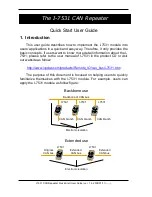
WESROC© RMS Satellite Repeater – User Manual
Metrotel Corporation of Minnesota, Inc.
Revision A. May 7, 2008
Page 4
Wesroc® RMS Satellite Repeater Operation
General
The Wesroc® RMS Satellite Repeater is designed to work in conjunction with all
other Wesroc® RMS transmitters. The Wesroc® RMS Base Unit is used for
regular communications to the Wesroc® Host Server over the Public Switched
Telephone Network. There are plenty of potential remote monitoring sites where
access to the PSTN does not exist, or is cost prohibitive. There exist cellular
solutions for communication, but they are costly and are still limited to areas
where access to cellular carriers is available. The Satellite Repeater was created
to solve the problem of remote monitoring in locations where conventional
communication is unavailable.
The Satellite Repeater operates by receiving data packets from Wesroc® RMS
transmitters. These could include Gas Meters, Thermometers, Level Sensors,
etc… It is also intended to be forward compatible with Wesroc® application
sensors which are not yet conceived. The data is then sent through the
Globalstar Simplex data network. This network consists of Low Earth Orbiting
Satellites (or LEOS) which repeat the data signals. These repeated signals are
then received by Globalstar®’s ground segment stations. Globalstar® recognizes
the Electronic Serial Number of the Satellite Repeater and associates the
received packets with Independent Technologies. The data is then sent via the
internet to the Wesroc® RMS SatComm server which processes and presents
the data to the Wesroc® RMS Host Computer system where it is made
accessible to the Host Administrators.
The use of the Globalstar® Simplex data network is a for-fee service.
Independent Technologies is charged for the setup and operation of the Satellite
Repeater. Independent Technologies then charges it’s customers appropriately
for the use of the Wesroc® RMS data provided through this system.
Wesroc® RMS Satellite Repeater Location
The satellite repeater must receive Global Position System signals to acquire
time and date. GPS information also is required for proper Globalstar® simplex
channel selection based on it’s proximity to Radio Astronomy Sites. The satellite
repeater must also transmit the signal used by the Globalstar® simplex data
network. These two requirements necessitate that the satellite repeater be
placed in a location that has a clear, unobstructed, view of the sky. Typical
locations include pole mounting, mounting the satellite repeater at the point of a
roof, etc… The satellite repeater comes with a 25 foot power cord. This allows for
the AC power source to be located inside of a building or structure, or properly
protected area.





































